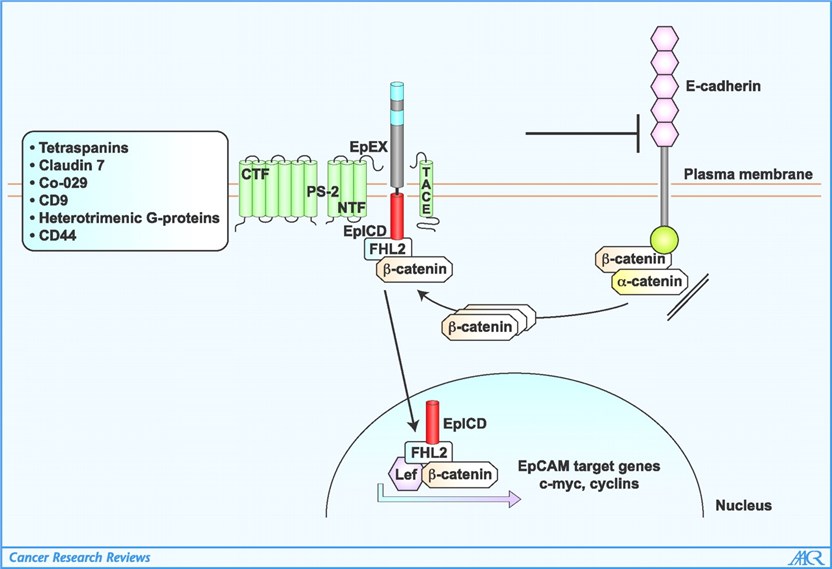EpCAM Assay Portfolio Service
Epithelial Cell Adhesion Molecule (EpCAM) Structure
Epithelial cell adhesion molecule (EpCAM, also known as CD326 or TACSTD1), is a type I transmembrane glycoprotein, consisting of 314 amino acids with 40 kDa in molecular weight. EpCAM is comprised of an extracellular domain with epidermal growth factor (EGF) and thyroglobulin repeat-like domains, a single transmembrane domain, and a short 26-amino acid intracellular domain called EpICD. Two EpCAM subunits form a heart-shaped dimer on the cell surface. EpCAM is expressed in a variety of human epithelial tissues, cancers, progenitor, and stem cells, and is also a cell surface marker on the various stem and progenitor cells. EpCAM is highly expressed in epithelial cancer, including colon and breast cancer.
Signaling Pathways
Intracellular EpCAM is cleaved by two important proteins named tumor necrosis factor α converting enzyme (TACE) and peresenilin 2 (PS-2) as EpEX and EpICD. EpEX is released out of the cell, whereas EpICD is released into the cytoplasm. Meanwhile, β-Catenin accumulates in the cytoplasm due to the inhibition of the β-Catenin degradation complex (AXIN, GSK3β, APC) in the Wnt-β-Catenin pathway. With help of four and one-half LIM domain protein 2 (FHL2), EpICD and β-Catenin enter into the nucleus. These nuclear complex proteins regulate gene transcription and activate the EpCAM target gene such as Cyclins and C-myc. In addition, the release of soluble EpEX may then trigger an autocrine cell-signaling response.
 Fig.1 Signaling pathways of EpCAM. (Munz, 2009)
Fig.1 Signaling pathways of EpCAM. (Munz, 2009)
Functions of EpCAM
-
Cell adhesion. EpCAM is a homophilic Ca2+-independent cell-cell adhesion molecule in cells. In addition, EpCAM can modulate the strength of cellular adhesion mediated by E-cadherin by disrupting the link between α-catenin and F-actin. However, EpCAM is highly expressed in tumor tissues, and the tumor tissues usually lose organized adhesive structures and cell polarity.
-
Cell junction. EpCAM is essential for cell junctions. It interacts with several important cell adhesion molecules (CAMs) and regulates adhesive structures between cells and cell-matrix, including adherens junctions, and tight junctions, desmosomes, and hemidesmosomes.
-
Cell proliferation. Several in vitro and in vivo studies have shown that overexpression of EpCAM induces cell proliferation, whereas downregulation of EpCAM decreases cell proliferation.
-
EpCAM and stem cell. EpCAM plays an important role in the induction and/or maintenance of proliferation and cellular differentiation of progenitors, stem cells, induced pluripotent stem cells, cancer cells, and cancer stem cells.
-
Epithelial to mesenchymal transition (EMT). Regulation of EpCAM during EMT seems to be context-dependent. Some results are in favor of the downregulation of EpCAM expression during EMT. Interestingly, EpCAM could also contribute to the regulation of EMT by suppressing ERK activity and SNAIL2 expression, defining a double-negative feedback loop. On the other hand, some studies have suggested a promoting role in EMT for EpCAM.
-
Migration and invasion. Results on cancer cell lines about EpCAM are also conflicting and seem to be context-dependent. EpCAM that promotes invasion of breast cancer cells may be via upregulation of IL-8 expression. On the opposite, direct involvement of EpCAM in the migratory phenotype of esophageal carcinoma was tested upon siRNA-mediated downregulation of EpCAM. An increased migration capacity of cells after EpCAM knock-down was paralleled by an increase of vimentin expression.
Applications of EpCAM in the Tumor
EpCAM is an attractive target for tumor diagnosis and therapy because of its tumor-specific overexpression. EpCAM, also called tumor-associated calcium signal transducer protein 1-precursor (TACSTD1), is a marker for most epithelial cancer. EpCAM levels are increased in most epithelium-derived tumors. High expression levels of EpCAM usually correlate with poor prognosis, such as in breast cancer, ovarian cancer, and pancreatic. EpCAM has been used as a target for many immunotherapeutic approaches, including treatment with monoclonal antibodies, the development of cancer-targeting antibodies, and vaccination strategies.
What Can We Offer?
EpCAM is a pan-epithelium marker, which is expressed in a great variety of differentiated epithelia. Importantly, EpCAM is the central target molecule for the enrichment and characterization of systemic tumor cells with prognostic and metastatic potential. Creative Biolabs provides a full set of EpCAM assay portfolio services for research, including but not limited to:
-
EMT assay
-
EMT marker assay
-
Cell proliferation assay
-
Colony-forming efficiency assay
-
Wound healing assay
-
Transwell assay
-
TACE activity assay
-
Tumorsphere formation assay
-
Cytotoxicity assay
-
ELISA
-
Immunohistochemistry and immunofluorescence
-
Western blotting
Creative Biolabs provides a complete portfolio of tumor marker assays such as EpCAM assay portfolio service. We are continually expanding our portfolio by adding new tumor marker assays and applications and broadening our network with competent partners. Our goal is to help our clients to achieve research goals as quickly and as easily as possible. Please feel free to contact us.
Reference
-
Munz, M.; et al. The emerging role of EpCAM in cancer and stem cell signaling. Cancer Res. 2009, 69(14): 5627-5629.
For Research Use Only | Not For Clinical Use


 Fig.1 Signaling pathways of EpCAM. (Munz, 2009)
Fig.1 Signaling pathways of EpCAM. (Munz, 2009)
 Download our brochure
Download our brochure